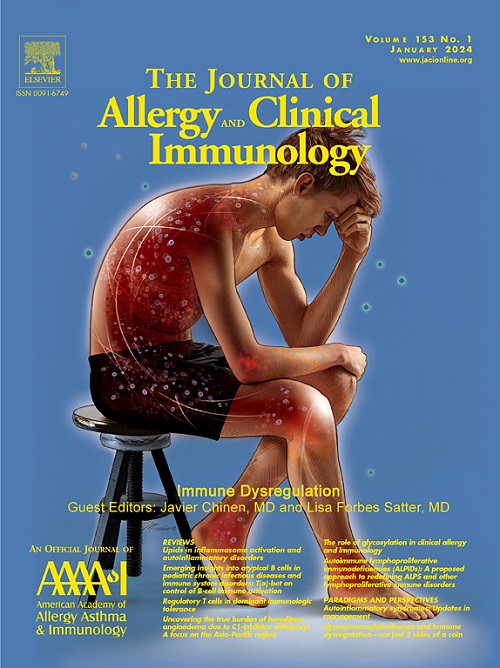Subclinical inflammation precedes atopic dermatitis relapses.
IF 11.4
1区 医学
Q1 ALLERGY
引用次数: 0
Abstract
BACKGROUND Atopic dermatitis (AD), a widespread inflammatory skin disease, is characterized by disease recurrence, even after successful treatment. Past clinical research has mainly focused on understanding the active disease state as opposed to what drives and triggers AD relapses in the first place. OBJECTIVE To elucidate the unknown molecular mechanisms behind AD relapses. METHODS An observational clinical study with patients in remission was conducted, comparing biopsies from skin that would relapse within the next weeks with skin that stayed in remission using single-cell-RNA sequencing and immunohistochemistry analyses. RESULTS Signs of subclinical inflammation were present in the clinically healthy appearing pre-relapse state. On the one hand, we detected molecular signals reminiscent of active AD, such as epidermal barrier dysregulation, chemokine signaling, increased vascular permeability and first signs of T cell activity and infiltration. On the other hand, we also observed signals for processes specific to the pre-relapse state, including epidermal growth factor receptor (EGFR) signaling and macrophage phagocytosis. CONCLUSION Taken together, this work uncovers novel aspects of AD development, and putatively paves the way for new therapeutic approaches that are specifically designed to prevent AD recurrence.亚临床炎症先于特应性皮炎复发。
背景:异位性皮炎(AD)是一种广泛存在的炎症性皮肤病,其特点是即使在成功治疗后也会复发。过去的临床研究主要集中在了解活动性疾病状态,而不是首先驱动和触发阿尔茨海默病复发的原因。目的探讨阿尔茨海默病复发的未知分子机制。方法对缓解期患者进行了一项观察性临床研究,使用单细胞rna测序和免疫组织化学分析,比较了在未来几周内复发的皮肤活检和缓解期皮肤活检。结果在临床健康表现为复发前状态时,存在亚临床炎症征象。一方面,我们检测到与活动性AD相关的分子信号,如表皮屏障失调、趋化因子信号、血管通透性增加以及T细胞活性和浸润的初步迹象。另一方面,我们还观察到复发前状态特异性过程的信号,包括表皮生长因子受体(EGFR)信号和巨噬细胞吞噬。综上所述,这项工作揭示了阿尔茨海默病发展的新方面,并为专门设计用于预防阿尔茨海默病复发的新治疗方法铺平了道路。
本文章由计算机程序翻译,如有差异,请以英文原文为准。
求助全文
约1分钟内获得全文
求助全文
来源期刊
CiteScore
25.90
自引率
7.70%
发文量
1302
审稿时长
38 days
期刊介绍:
The Journal of Allergy and Clinical Immunology is a prestigious publication that features groundbreaking research in the fields of Allergy, Asthma, and Immunology. This influential journal publishes high-impact research papers that explore various topics, including asthma, food allergy, allergic rhinitis, atopic dermatitis, primary immune deficiencies, occupational and environmental allergy, and other allergic and immunologic diseases. The articles not only report on clinical trials and mechanistic studies but also provide insights into novel therapies, underlying mechanisms, and important discoveries that contribute to our understanding of these diseases. By sharing this valuable information, the journal aims to enhance the diagnosis and management of patients in the future.

 求助内容:
求助内容: 应助结果提醒方式:
应助结果提醒方式:


